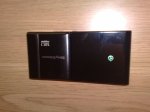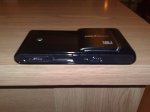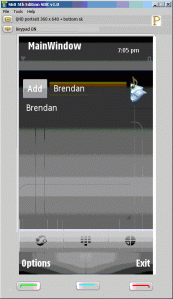I recently purchased a shiny new Satio from Phones4U. I really wanted a new phone, but even though I work in the industry I wouldn’t call myself a phone geek, so couldn’t justify the purchase of an iPhone or a Hero. I needed something practical, but also a bit interesting. With my daughter having been born last month, we’d been using the N82 for photography. What I really wanted was a replacement for this, i.e. something just as good at taking photos, but newer. I’d heard some not nice things about the stability of the software on the Satio, including the high profile stories of CPW and Phones4U taking it off the shelves. At this point though the Satio had got a prompt update and considering that it’s been said to have the best camera ever on a phone, I decided to brave it. So I placed the order, getting a pretty decent deal out of it. A two-year contract (big commitment, I know) but only £25 a month on O2. Considering the Satio is brand-spanking new and pretty top range that’s quite a bargain. It arrived in the post a few days later and I got to grips with it. What I’m giving you here is with about a week’s use, a reasonable amount of time to learn something about the phone. It’s based on S60 5th Editon/Symbian^1 (although, as I’ll tell you later in more detail, it’s closer to Symbian^2 in terms of what’s in there) so the interface was familiar for the most part.
Part 1 : Hardware
As is customary, I’ll start off with the hardware. Since I can’t take a picture of the Satio with itself here are some from it’s predecessor (that’s the N82 I mentioned):
As you can see, it has a nice big 3.5″ screen. I think this a good size. It looks impressive but still just about allows one-handed operation, which is one of my primary criteria for choosing a phone. It’s a resistive screen, which means by it’s very nature it’s not going to be 100% sensitive, but if you always remember to give a firm enough press (most of the time that’s way more than enough) then you’ll be good. I’ve heard bad things about the sensitivity, but certainly on the unit I got (with the new firmware) I haven’t found it to be below expectations for a resistive screen.
The distinguishing feature of the unit, in more way than one, is the protrusion on the back which serves as the camera cover. Some say it looks odd, but I think it gives the Satio a nice feel in the hand. The slide mechanism on it is pretty satisfying as well, having a good thwump when opened and closed. The rest of the body houses the 1000mAmph battery. Now, this looks tiny, with even my 5800 having a 1320mAmph battery. It’s a little unfair to judge the ‘battery’ criteria by pure ampage though. There is way, way, way more to power management on a device than this and we’ll discuss that in a separate posting later.
The hardware controls on the Satio have a pretty nice feel and all the usual suspects are here, as well as the necessary ports. Starting from the top and working clockwise, we have the power button in the usual place. I found it a little hard to locate it at times, which I guess is good because it means that you won’t be turning it off by accident. As the fastest route to profile switching (for all the merits of the Satio homescreen it doesn’t have the neat profile/calendar shortcut of the 5800), this was a little annoying sometimes though.
There are up/down keys on the top of the right hand side of the device. These function as volume and zoom keys (in the gallery) and are nice and sturdy. Some media related keys follow. One with a ‘play’ icon on it to go to the photo gallery and one to switch between camera and video. A good camera button is next, which works as expected. Depress it to zoom and push to shoot, simple.
Round the bottom of the display are the usual triumvirate of keys found on S60 devices. A green ‘call’ key, white ‘application’ key and red ‘cancel’ key. They’re quite thin, making space for more screen, but this doesn’t cause any problems.
Going up the left hand side of the Satio, we come across what is thankfully a Micro-SDHC slot. Thank Sony Ericsson for not continuing with their ridiculuous proprietary formats! Micro-SDHC of course means that the maximum size of card is a mighty 32Gb (although these are expensive at the minute), but mine shipped with an 8Gb one which is turning out pretty adequate for my needs so far. With the massive photos the Satio takes this might not stay true for long though!
Disappointingly, the very next entry in the list of hardware features throws the trend of standardising the ports out the window and we are presented with one of those flat ports with the tooth holes in them. Now, there may be a rationale for this choice (faster data transfer, better use of space) but the major problem is that you need to keep a close eye on the adapter cable that comes with the Satio, or you may be sans headphones until you can find a replacement. To be fair to Sony Ericsson, at least they only have the adapter and not the whole pair of headphones with that connector. If you don’t like the ones in the box you can at least replace them. Oh, the other advantage of this scheme is that the same port can be used for USB cable, AV cable, charger and headphones so it does save a lot of space. In a clever piece of thinking, they’ve also put a port in the back of the chargers connector, which means you retain the ability to charge and use the headphones (or USB or AV cable) at the same time. The last thing to note is that the Satio supports USB charging, so it can get some juice while transferring data to and from your PC.
To finish up, we have a very very nice slide lock. It’s got a really good feel to it – way better than the 5800. It’s got a nice, satisfying snap to it and the bumps on it make it easy to locate. One problem, which I’m not sure to blame on it or the headphones, is that the shape of the headphone connector causes it to sit pretty tight to the slide lock. When you’re listening to music it can be pretty awkward unlocking the device.
The overall feel of the device itself is good. It is made of plastic for the most part (I think the camera cover is metal) but it feels solid and not too heavy. Apart from the dubious decision to go with the proprietary port for the cables, I would rate the Satio really highly in terms of the hardware. I should note that I have no experience of capacitive screens so maybe if I had I would be more put off by the resistive screen on the Satio. As it stands though, close to top marks.



 Posted by brendandonegan
Posted by brendandonegan 



